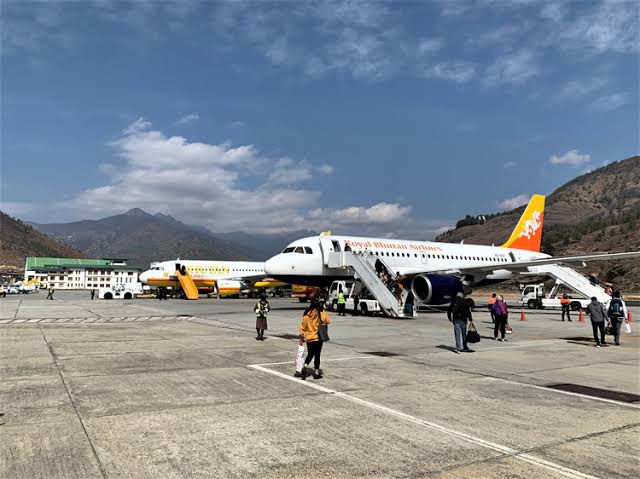Flying higher and further : Druk Air

In one of the boldest moves by our national airline, Druk Air, a firm order has been placed for five new aircrafts – three Airbus A320neo and two Airbus A321XLR. Bold ambitions call for bold decisions, and I must commend our national carrier for this move. In my view, it is a huge step forward for the Gelephu Mindfulness City (GMC) project and also for Bhutan as a nation. The news, while it was covered by the mainstream media agencies, did not make much of a splash across social media, where greater dissemination and education on a topic happens these days. So, let me share my broader understanding on the larger benefits.
Destination Gelephu
While the A320neo may be a replacement for the ageing A319 fleet, the two A321XLR are obviously for Gelephu. The Airbus A321XLR is the largest aircraft in the A320 family – and also a great choice given that the airline does not have to maintain a separate set of crews to fly them. The A321XLR can accommodate anywhere between 180 to 220 passengers depending on the cabin configuration. It is a single-aisle wide-body airliner with a maximum range of 8700 km (8,400 km, according to latest changes), which makes it possible for the airline to extend its wings for direct flights to distant destinations such as Tokyo, Perth, or Istanbul. XLR stands for “extra-long range”.
The Airbus A321XLR with a longer fuselage wouldn’t be able to operate out of Paro with the current runway length. Therefore, they could be solely destined for Gelephu, where the new international terminal and a longer runway will be built. Gelephu could become the operational base for these aircrafts. If this is so, it is significant because, firstly, in the airline business, a base airport means that the aircrafts will be stationed there permanently for both operations and maintenance. Consequently, a good number of employees such as pilots, maintenance engineers, ground staff, and even cabin crews will have to be based there, thus opening direct opportunities for local businesses in terms of housing, hospitality and other businesses. As the airport itself becomes fully operational, if well planned and strategized, it can then spur a chain of opportunities for other sectors, such as cargo, catering, transportation, tourism, trade, innovation and other sectors. The list is endless.
Second, the aircraft with its longer operational range (distance between two places) could be deployed for direct medium and long-haul flights to destinations such as Australia, Middle East, South East Asia and the Far East. This will be vital because if Gelephu is to attract foreign investments and investors, direct air connectivity to other economic hubs, and direct flights to global hub airports such as Hong Kong, Dubai, Frankfurt and Singapore will be the key. Business travellers, especially those higher up in the corporate ladder are super sensitive to travel time.
Third, here are some fun facts. By 2050, which is just 25 years to go, five of the 10 biggest economies will be within the operational range of the Airbus A321XLR. Furthermore, by 2035, which is just 10 years from now, seven of the 10 biggest cities in the world by population will be within the operational range of Airbus A320neo.
Paro – the gateway to Bhutan
As the GMC project gathers steam, one question that crops up in my circle of friends is – what would happen to Paro? In the sense that, would this place see a decline? To answer that simply, it will continue to retain its status, or even get vibrant thanks to the GMC Project. Paro will continue to be the international gateway to Bhutan – especially for leisure travels and cultural tours. In fact, with new routes to the Middle East being launched from October of 2024, it could spur more tourism arrivals. Dubai happens to be just a flight away from any major city on earth. It will be especially convenient for passengers from Europe and the US. Of course, Bangkok and Delhi are well connected too, but Dubai has become the global hub for air travel.
One issue to be addressed, though, is that unlike business travellers, leisure travellers prefer cheaper fares over travel time. Bhutanese airlines have a long way to go in terms of a more dynamic pricing – preferring instead to maintain a high and flat rate, and fly with unsold seats. This has led to losing business to airlines operating in and out of Bagdogra. Likewise, the Bhutanese diaspora, who are dispersed in over 100 countries, will also factor in the airfare as the major determinant on how frequently they can travel home.
Looking beyond profits
Over 70 countries would fall within the operational range of the Airbus A321XLR. In one of my earlier articles, I have mentioned the role of national flag carriers as furthering national identity through projecting the country internationally. Countries like Japan, Malaysia and a few middle eastern states have propelled their flag carriers to promote their national identity world-wide, which in many cases did not make business sense. To this end, popular bloggers like Yeshey Dorji have called for Druk Air to be delinked from the business-centric goals of Druk Holdings and Investments, and let it be subsidised to focus on nationhood and connectivity – or find a balance between profit-making and nation-building.
Furthermore, with the call for everyone to come together, work hard and co-create the royal vision for Gelephu, the strategic role that our airlines can play cannot be understated. I can only reiterate that efficient air transport will promote international trade and investments, and more importantly facilitate the movement of people and goods. Besides, as a small landlocked country, a reliable and convenient air connection to Gelephu is not only of vital importance, it could also help physically promote brand Bhutan to the world. This is what Singapore Airlines achieved for Singapore in the 1970s. Bhutanese people are generally hospitable, kind, and fun. It won’t take long to build a global airline with the best onboard services and customer care.
And not the least of considerations, is the Bhutanese diaspora that is spread across the planet – especially in Australia, Japan and the Middle East. A direct air connection will make it possible for our people to conveniently travel home and more frequently. This might open up a circular migration and investments, and acquisitions of properties while at the same time allowing children to be kept connected to their roots. Of course, you can always hop on to a Thai Airways or an Air India flight, but there is nothing like getting on board an aircraft that carries your own national flag from end to end. You already feel safe, proud, and at home as soon as you are on board, although the aircraft may be still attached to the airport terminal in a foreign land.




